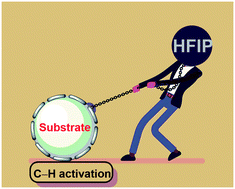Role of hexafluoroisopropanol in C–H activation
Abstract
1,1,1,3,3,3-Hexafluoroisopropanol (HFIP) has emerged as an attractive tool in developing and facilitating C–H activation/functionalizations. The hydrogen bond donating ability of this solvent coupled with its enhanced acidity and reduced nucleophilicity has played an integral part in boosting the reactivity and stereoselectivity of C–H functionalization reactions. Several C–H activation reactions necessitate the requirement of HFIP which plays a central role in developing these methodologies. Herein, this report showcases the importance of HFIP in developing C–H activation reactions in organic synthesis.

- This article is part of the themed collection: Reaction Chemistry & Engineering Emerging Investigators


 Please wait while we load your content...
Please wait while we load your content...